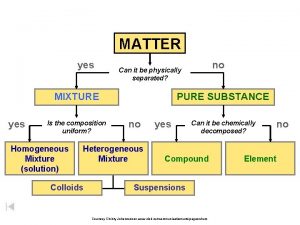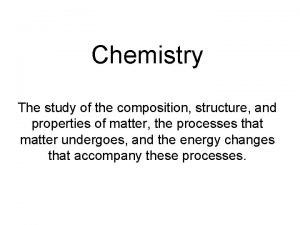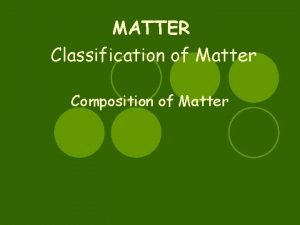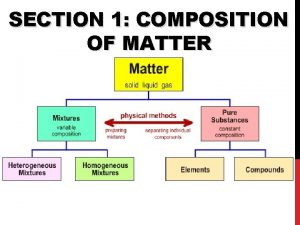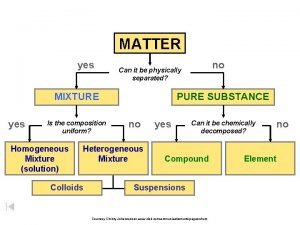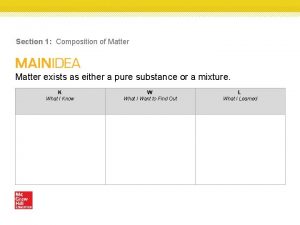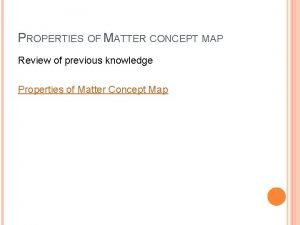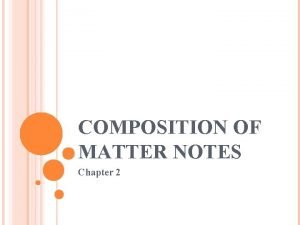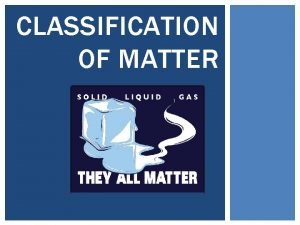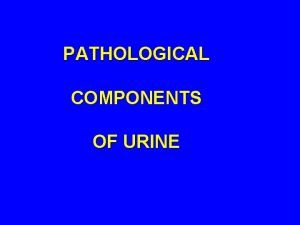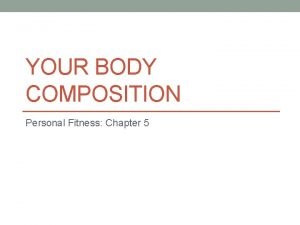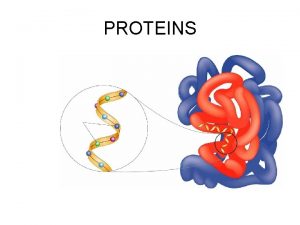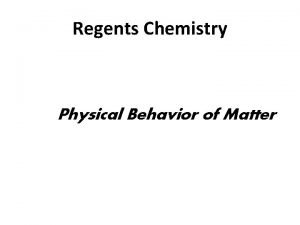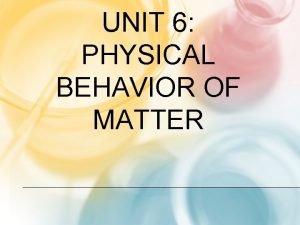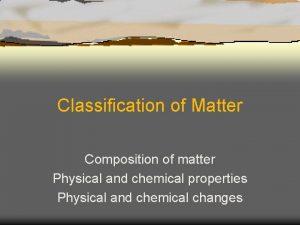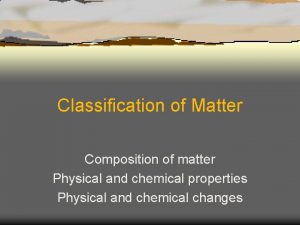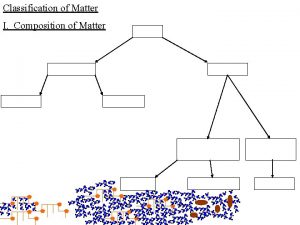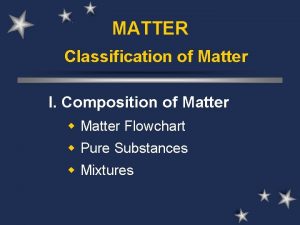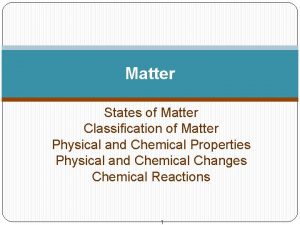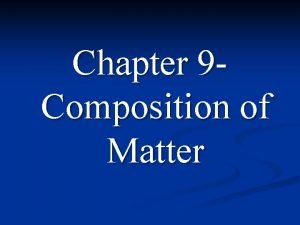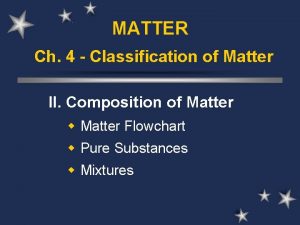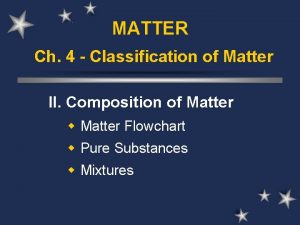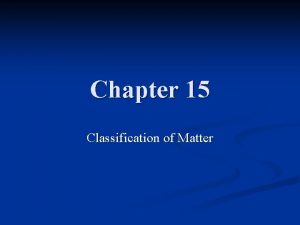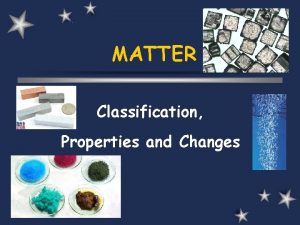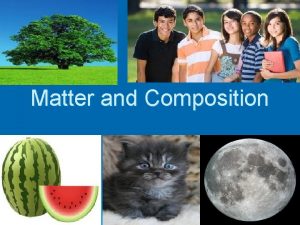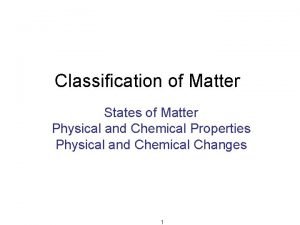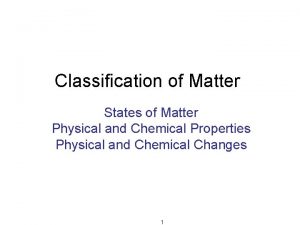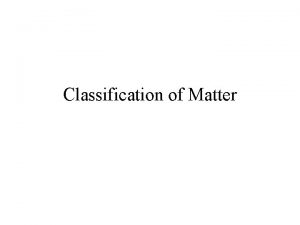Classification of Matter Composition of matter Physical and



























- Slides: 27

Classification of Matter Composition of matter Physical and chemical properties Physical and chemical changes

Pure Substances ÜA pure substance is a substance that cannot be broken down into simpler components by physical means. Ü Examples: elements and compounds. Ü Elements are substances that are composed of all the same atoms.

Examples of Elements Ü What elements do we use everyday? Ü Carbon- graphite in pencils, diamonds Ü Copper- electrical wires, pennies Ü Oxygen- breathing Ü There are 90 elements found in nature. Ü More than 20 others have been synthesized in the lab.

Compounds ÜA compound is a substance in which the atoms of two or more elements are combined in fixed proportions. Ü Chlorine and Sodium are toxic alone but when put together in a 1: 1 ratio, they make up salt.

Mixtures ÜA mixture is a material made up of two or more substances that can easily be separated by physical means. Ü There are two types of mixtures: Ü Heterogeneous mixtures Ü Homogeneous mixtures

Heterogeneous Mixtures ÜA mixture in which the different materials are easily distinguishable is a heterogeneous mixture. Ü Heterogeneous mixtures contain more than one phase. Ü A phase is a region with uniform properties, like density, structure and heat capacity.

Homogeneous Mixtures ÜA homogeneous mixture contains gaseous, liquid or solid substances blended evenly throughout. Ü Example: cold soft drink ÜA solution is a type of homogeneous mixture of particles so small that they cannot be seen with a microscope and will never settle. Ü Example: vinegar

Colloids Ü Colloid comes from a Ü Like a solution, the Greek word for glue. components won’t Ü Colloids have some settle if left standing. properties of Ü Like a heterogeneous and heterogeneous homogeneous mixtures. mixture, there are Ü Examples: milk, paint, varying proportions fog of components.

Detecting colloids Ü One way to distinguish a colloid from a solution is by its appearance. Ü Colloids scatter light because the particles suspended are large. Ü The scattering of light by a colloid is called the Tyndall effect.

Suspensions ÜA suspension is a heterogeneous mixture containing a liquid in which visible particles settle. Ü Example: muddy pond water

Physical Properties ÜA physical property is any characteristic of a material that you can observe without changing the identity of the substances that make up the material. Ü Examples of physical properties: color, shape, size, melting point, boiling point, heat capacity, mass

Behavior Ü Some physical properties describe the behavior of a substance. Ü Ductility- the ability of a metal to be drawn into wires Ü Magnetism- the ability to be attracted by a magnetic field Ü Malleability- the ability of a metal to be hammered into thin sheets

Behavior Ü Viscosity- flow the resistance of a fluid to Using Physical Properties to Separate Ü How might you separate a mixture of iron and sand? Ü What approach would you take to separate salt from water?

Physical Change ÜA change in shape size or state of matter is called a physical change. Ü These changes may require energy changes, but the material itself remains unchanged. Ü Examples of state changing processes: freezing, melting, evaporation, sublimation, boiling, condensation

Chemical Properties ÜA chemical property is a characteristic of a substance that indicates whether it can undergo a chemical change. Ü One such property is flammability. Some chemicals are photosensitive and decompose when exposed to light. Ü Chemical properties are often related to the structure of a particular molecule or compound.

Detecting Chemical Change Ü There are 4 clues that a chemical change is taking place: 1. A color change is observed. 2. Heat is released or absorbed. 3. A precipitate is formed. 4. A gas is released. ☺A precipitate is a solid that forms as a result of mixing two or more solutions.

Chemical Changes Ü The only real proof that a chemical change or reaction has occurred is a new substance is produced. Ü For example, what forms on iron when exposed to oxygen? Is this a chemical or physical change? Ü Does the separation of an element from its ore require chemical or physical changes?

Intensive and Extensive Properties Ü Intensive properties Ü Extensive properties do not depend on the amount of matter present. Ü Examples: melting Ü Examples: mass, point, boiling point, volume and amount density and of energy conductivity of electricity and heat

Is mass lost during a chemical reaction? Ü Wood is combustible, meaning that it will readily burn. Will the pile of ash remaining after the wood is burned weigh the same as the original log? Ü Where did the excess weight go? Ü You might realize that if you combined all of the oxygen that escaped along with the other gases… the before and after products would be the same!!!

The Law of Conservation of Mass Ü This law states that the reactants and the products in a chemical reaction have exactly the same mass. Ü Antoine Lavoisier came up with this law.

Separating Mixtures Ü 1) When is it appropriate to use evaporation to separate a mixture? Ü How evaporation proceeds: Ü 1) Rapid evaporation (or vaporization)results from heating the solution to boiling to ensure evaporation happens quickly Ü If you leave the solution out at room temperature, most of the liquid will evaporate eventually. The crystals formed will be larger.

Filtration Ü When is it important to use filtration? Ü 1) When you are separating a solid from a liquid… like a precipitate from an aqueous solution.

Closed v. Open Systems A closed system is a system which is isolated so that it cannot exchange matter or energy with its surroundings and can therefore attain a state of thermodynamic equilibrium. Ü Example: hand-boiler distillation Ü Ü An open system is a system across whose boundaries both matter and energy may pass. Ü Example: water cycle

Distillation Ü The process of distillation involves the physical separation of substances in a mixture of 2 liquids with different boiling points by the evaporation of a liquid and recondensing of its vapor. Ü This process is often used in industry. Natural oils, such as mint and lavender, are separated using distillation.

Chromatography Ü There are several types of chromatography: Ü 1) Paper chromatography Ü Used to separate a mixture of liquids Ü There is a stationary (uniform absorbent paper) and mobile (liquid solvent or mixture of solvents) phase. Ü Some components of the mixture are more attracted (Think IMFs) to the paper or stationary phase and move slowly. Other components are more attracted to the solvent or mobile phase and travel quickly up the paper.

Paper Chromatography Ü It is important that the solvent start below the marked mixture. Ü It is also important that you mark the solvent front (the highest point reached by the solvent). Ü An Rf value or retention factor, can be calculated as such: Ü Rf= distance traveled by compound (cm) distance traveled by the solvent (cm)

 Classification of matter section 1 composition of matter
Classification of matter section 1 composition of matter Classification of matter section 1 composition of matter
Classification of matter section 1 composition of matter Composition of matter section 1
Composition of matter section 1 Copper does it have a uniform composition
Copper does it have a uniform composition Study of composition structure and properties
Study of composition structure and properties Properties of solids liquids and gases
Properties of solids liquids and gases Matter flow chart
Matter flow chart What is dissolution
What is dissolution The composition is uniform
The composition is uniform Flowchart of how matter is classified
Flowchart of how matter is classified What is composition in matter
What is composition in matter Composition of matter section 1
Composition of matter section 1 Classifying matter concept map
Classifying matter concept map Composition of matter flow chart
Composition of matter flow chart Number of proton
Number of proton A type of matter with a fixed composition
A type of matter with a fixed composition Physical composition of urine
Physical composition of urine Body composition, physical activity
Body composition, physical activity Gray matter in the brain
Gray matter in the brain Cerebral aqueduct
Cerebral aqueduct Gray matter and white matter
Gray matter and white matter Gray matter
Gray matter Protein elements
Protein elements Physical behavior of matter heating and cooling curves
Physical behavior of matter heating and cooling curves Physical behavior of matter heating and cooling curves
Physical behavior of matter heating and cooling curves True or false: chemical and physical changes alter matter.
True or false: chemical and physical changes alter matter. Physical rate fences
Physical rate fences Physical fitness test grade 9
Physical fitness test grade 9



